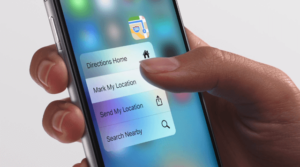Yesterday, I highlighted the technology that Apple has introduced to add an element of pressure sensitivity to the touch input sensor of its iPhones. Of course, that has encouraged others to go in this direction. Dimensional Touch Inc., a development-stage company based on technology developed at the University of California San Diego (UCSD), is just such a company independently developing force sensing technology.

I recently had the opportunity to interview the principals at Dimensional Touch (DT) for Display Daily (DD) . Note that the interview with Dr. Siarhei Vishniakou and Dr. Matthew Hedayat, CEO of Dimensional Touch has been edited for length, clarity and grammar.
(DD) Can you describe the origin of Dimensional Touch and the firm’s technology?
(DT) The existing capacitive touchscreen can only detect the X-Y coordinate(s) of the spot you touch. While the touchscreen can measure where you touch, it cannot measure how hard you are pressing. The ability to measure force opens the door to new possibilities with richer user interface and more sophisticated, yet natural, controls.
There have been many attempts to measure force by a variety of technologies in the last decade. However, none have been reliable and cost effective enough to be considered for integration into the consumer electronics, until the introduction of iPhone 6S in 2015.
At Dimensional Touch, Inc., we have developed a transparent pressure sensor technology, where each pixel acts as a transistor and a pressure sensor simultaneously. The unique device structure was first developed, demonstrated, and patented in the laboratory at UC San Diego. In this pressure sensing method, each device can be as small as 5 µm, and can act as a switch, allowing the isolation of a single device in a matrix of multiple sensors. This property allows the pressure sensors to be connected in a row-and-column fashion, thus minimising the number of required contacts and allowing the pressure sensor matrix to scale up to large dimensions. In contrast, other pressure sensing technologies either require an additional layer of switches integrated next to each pressure sensor, or require individual routing. This means that the new technology proposed by Dimensional Touch requires fewer layers, and can be produced at lower cost. The novel sensing scheme also creates additional advantages, such as independent sensors, fast switching, high resolution, low weight, virtually zero thickness and compatibility with existing manufacturing equipment.
 Dr. Hedayat and Dr. Vishniakou of Dimensional Touch, Inc.
Dr. Hedayat and Dr. Vishniakou of Dimensional Touch, Inc.
(DD) Can you describe the current status of your business development and the state of development of your technology?
(DT) We have demonstrated the operation of an 8×8 [sensor array] a few years ago, and have since been working on improving the sensitivity and device performance. Recently, we have made two prototypes with 97% yield across the chip. We have developed the technical spec for the product and it is ready to be presented to potential customers. We are currently developing a 16×16 array of sensors, and have identified a facility that can run a pre-mass production run of our process. We are limited to a substrate size of about 1″ x 1″ in our existing cleanroom. Our next step is to develop a 4″ x 8″ prototype in order to finalize the specifications and provide [the technology] to potential customers for evaluation.
(DD) Other force sensing touch sensors have been demonstrated and have been utilized in products. How does the Dimensional Touch technology differ from Apples’ 3D Touch sensor or the force sensing resistor technology of Tangio (tangio.co)?
(DT) Indeed, there has been a number of startups (and large OEMs) that have been trying to achieve pressure sensing. Our technology is unique because our transparent pressure sensors also act as switches. This means that no additional addressing elements need to be present alongside the pressure sensors in order to select the desired pixel in the array. First off, we are the only technology seeking a complete replacement for capacitive touch. Every other tech is seeking to add more sensors and readout hardware to the capacitive touchscreen. Let’s compare each of the technologies one at a time.
In Apple’s 3D Touch case, they have a capacitive touchscreen on top of the display for readout of the location of touch, and also an additional layer of capacitive sensors underneath the display. There is a gap between the display and an additional layer of force sensors, so that the display deflects when pressed by the user, and causes the capacitance to change. The addition of 3D Touch in Apple’s case caused a major redesign of the phone, and resulted in an increase of the display assembly weight by 17 grams, and a total phone weight increase by 11% (http://tinyurl.com/oudxcq8). In our case, the technology is replacing the capacitive (touch screen), and would cause zero weight increase, and zero thickness increase. Moreover, a single scan would provide you with point-by-point information about pressure. This data can be processed to obtain the location of touch, as well as the amount of force. By our initial estimates, we should draw about the same amount of power as is currently used by the capacitive touchscreen.
In the case of force-sensing resistors from Tangio, they cannot be made transparent. Therefore, they cannot be used for touchscreen applications. The activation force is 10g – 30g (http://tinyurl.com/h6s8sx6), while our technology can detect pressure as small as 1 kPa (which is about 3g), the threshold of human touch sensitivity.
Apple is credited with bringing pressure-sensing touch to the mass market(DD) What are the advantages of your force sensing technology?
(DT) In addition to the cool features outlined above, one of our main selling points is that our technology is compatible with the existing manufacturing equipment that is currently being used to make capacitive touchscreens. Therefore no additional capital investment is necessary. The process and materials are similar. So, we expect the production cost to be on par with the capacitive tech.
In addition, our sensors are all-solid state. There are no moving parts involved, which means there is less opportunity for wear and tear. This also makes it easier for the OEMs to integrate our sensors into the phones, since the change would only entail the replacement of the capacitive layer. Actually, we also think that it may be possible to use the existing capacitive touch controllers to drive our sensors. We are currently checking on that with one of the large touchscreen controller suppliers. There are some additional advantages of our approach:
- Super high resolution. Our sensors can be as small as 50 µm (we have tested them as small as 5 µm), so there’s unlimited possibility to scale the array to the desired dimensions. In addition to matching the existing technology’s 4-5 mm pitch, we can also get 2 -3 mm pitch, suitable for stylus operation. One millimeter resolution is considered the “holy grail of touchscreens”, as we learned from an expert at a large semiconductor design company. However, going beyond the touchscreen applications, there are other uses for super high resolution force sensing, which can only be served by our technology. One example is mechanical and bio-engineering applications, where there is a need to study the pressure distribution of parts on a very small scale.
- Latency: less than 1 ms. Latency is delay between the time from when the touchscreen is touched, to when the sensor is “aware” that a touch occurred. Typically touchscreens have a latency of about 10ms or more, which makes them not suitable for such applications as music devices. Humans can perceive a latency of about 10 ms. In our case, the built-in hardware latency is less than 1 ms, which makes our sensors ideal technology for music devices, such as music production, mixing, and DJ.
- Glove, water, and dust operation. Our sensors are activated purely by force, so it does not make a difference if a finger or a glove is pressing on the screen. In that case, underwater operation also becomes possible. What you will see is the uniform increase in pressure signal throughout the entire array as the device is submerged. Small variations of pressure due to finger will still be detected by the sensors.
- Stylus operation (passive). Expanding on the point above, any stylus can be used with a force-activated touchscreen, since there is no dielectric constant requirement on the object used to provide input.
(DD) Can you describe where you see your technology being first applied in a product?
We are first going after the mobile devices (specifically smartphones) market, since it is mature, well-established, and there is a clear need for force sensing, especially after Apple has paved the road. However, we understand that this is a significant undertaking. We have also identified other market niches that we are interested in pursuing that have smaller volume requirements. They have been alluded to throughout the discussion above. One of them is the music devices market, where we are offering ultra-low latency multi-touch transparent touchscreens and touchpads. Another niche is the water-operational touchscreens, for applications such as spas, marine equipment, underwater touchscreens, and so on.
(DD) What are the product advantages provided by application of your technology?
(DT) Apple is a market-maker. They have introduced and paved the road for this pressure-sensitive technology on the smartphones. This technology provides a 3rd dimension for the user. Already many app developers have implemented this feature into their programs, and the market will grow geometrically. Here are just some examples:
- CAD drafting. Pretend that you are working with a 3D object on your screen, which is composed of multiple blocks. Your task is to select a certain block within that object. How do you do that? It is easily done with force touch. Just press your finger over the block, then press harder/lighter in order to select a particular block in that plane. Companies specializing in multi-dimensional data visualization are currently “faking” this pressure information by looking at the amount of time that the finger is in contact with the screen, and the contact area of the finger. Clearly, the user experience is lacking with this approach.
- Gaming. Pretend that you are driving a car with a first-person view on a smartphone. Force touch gives you new, better controls for the car. Just keep the thumbs on the lower two corners of the screen. You can press harder with both hands to accelerate/decelerate, without removing fingers from the screen! Alternatively, you can press light with one finger and hard with another finger to turn.
- Pen-like experience and secure signature capture. Ultra-low latency combined with high resolution and high refresh rate enable pencil-like experience on your smartphone/tablet, without the need for a special stylus. One of the related products can be a security touchpad. Customer signatures are a nearly universal element of business engagement, and this solution will simplify, speed up, and secure the collection and management of those signatures. Pressure-sensitive electronic signature capture pad not only captures the shape of the signature, but also the amount of pressure applied at each point. This 3rd dimension is more difficult to forge, and cannot be detected visually.
As Dimensional Touch illustrates, the large and still expanding market for mobile devices remains a strong driver for technological innovation to provide improved user interfaces in a wide range of applications. – Phil Wright

